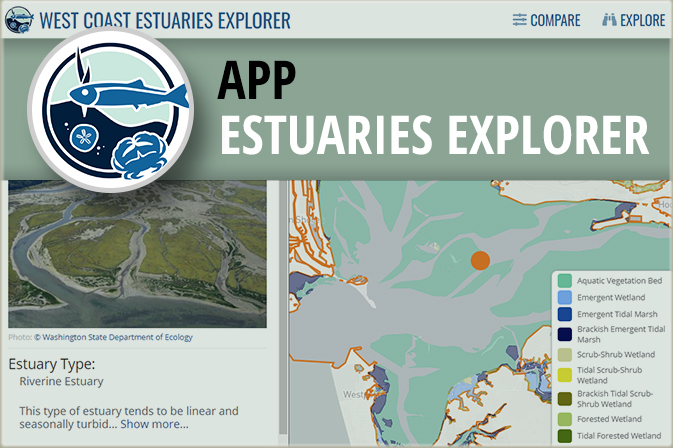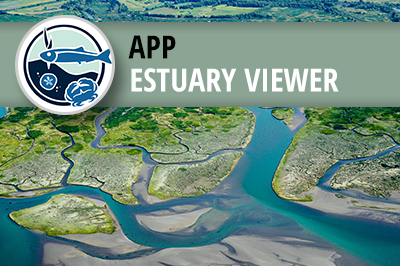Filters: Tags: {"type":"Catalog Filter Data Theme"} (X)
80 results (144ms)|
Filters
Date Range
Extensions Types
Contacts
Categories Tag Schemes Tags (with Type=Catalog Filter Data Theme ) |

This application enables you to compare estuaries to each other along the coastlines of Washington, Oregon, and California. You can combine dynamic filters and an interactive map to find specific estuary types you are interested in, such as large river delta estuaries which often have extensive diking; small, riverine estuaries that are at the lowest risk to fish habitat degradation; or estuaries contain species that interest you. Only want to compare estuaries in a specific area? Simply zoom the map in to that area, and the filters automatically update to show you the number of estuaries in that area that meet different conditions. You can also explore estuaries in more detail to find a specific estuary by name...
This map service layer provides information for projects funded by the 20 regional fish habitat partnerships through the National Fish Habitat funds. Projects funded since 2006 are represented in the service layer and the data are expected to be updated annually. Projects in the database range from on-the-ground restoration, partnership coordination, outreach and education events, and species distribution and habitat assessments.
Categories: Data;
Types: ArcGIS REST Map Service,
Map Service;
Tags: Habitat Restoration,
NFHP Cooperator,
Projects,
Spatial Data,
Visual
This shapefile is the official boundary of the Kenai Peninsula Fish Habitat Partnership.
Categories: Data;
Types: Downloadable,
Map Service,
OGC WFS Layer,
OGC WMS Layer,
Shapefile;
Tags: FHP Boundary,
FHP Product,
KPFHP,
Spatial Data,
Visual
This shapefile is the official boundary of the Midwest Glacial Lakes Partnership. The boundary was originally developed by the United States Fish and Wildlife Service and was updated in 2013 to reflect revisions from the Midwest Glacial Lakes Partnership, a recognized Fish Habitat Partnership (FHP) of the National Fish Habitat Partnership.
Categories: Data;
Types: ArcGIS REST Map Service,
ArcGIS Service Definition,
Downloadable,
Map Service;
Tags: Aquatic habitats,
FHP Boundary,
FHP Product,
FHPBoundary,
Fish habitats,
This CSV file contains landscape factors representing anthropogenic disturbances to stream habitats summarized within local and network stream catchments as well as 90 m local and network buffer of stream reaches throughout the conterminous U.S. The source datasets compiled and attributed to spatial units were identified as being: (1) meaningful for assessing fluvial fish habitat; (2) consistent across the entire study area in the way that they were assembled; (3) broadly representative of conditions in the past 10 years, and (4) of sufficient spatial resolution that they could be used to make valid comparisons among local catchment units. Variables summarized at the catchment scale include measures of anthropogenic...
Categories: Data;
Types: Citation;
Tags: Alabama,
Anthropogenic factors,
Arizona,
Arkansas,
California,
The Regional Estuary Assessment for the northern Gulf of Mexico represents an effort to develop, test, and implement a new assessment methodology for marine habitats that improves the analytical basis for identifying impacts to estuary fish habitats. Building from work completed for the National Estuary Assessment, this approach includes: 1) information on fish and shellfish presence/absence from over 70,000 sampling events collected over two decades, to better relate fish habitat condition to natural and anthropogenic variables; 2) data on natural factors, to better incorporate information on the natural susceptibility of individual estuaries; and 3) regional datasets not available on a nationally-consistent basis....
Categories: Data;
Types: ArcGIS REST Map Service,
Map Service;
Tags: 2015 National Assessment,
2015 National Assessment,
CONTINENT > NORTH AMERICA > UNITED STATES OF AMERICA > ALABAMA,
CONTINENT > NORTH AMERICA > UNITED STATES OF AMERICA > FLORIDA,
CONTINENT > NORTH AMERICA > UNITED STATES OF AMERICA > LOUISIANA,
This geodatabase contains 90 meter buffers of streams within the National Hydrography Dataset Plus Version 1 (NHDPlusV1). These buffers were developed by converting NHDPlusV1 flowlines to a 30m grid, then running a euclidean allocation function in ArcPy to generate buffer zones. For flowlines representing artificial paths within NHD area river polygons, buffers extend from the outside edges ("banks") of the polygon outward. The source code for buffer development can be found at https://github.com/ArthurCooper/NFHP-Buffer-Code.
Types: Citation;
Tags: 2015 National Assessment,
2015 National Assessment,
Alabama,
Arizona,
Arkansas,
This shapefile is the official boundary of the California Fish Passage Forum. The boundary was originally developed by the United States Fish and Wildlife Service and was updated in 2013 to reflect revisions from the California Fish Passage Forum, a recognized Fish Habitat Partnership (FHP) of the National Fish Habitat Partnership.
Categories: Data;
Types: ArcGIS REST Map Service,
ArcGIS Service Definition,
Downloadable,
Map Service;
Tags: Analytical boundary,
Aquatic habitats,
Boundaries,
CFPF,
FHP Boundary,
This geodatabase contains information on brook trout occupancy in the southern portion of the brook trout range (PA and south). Fish sample data from a number of state and federal agencies/organizations were used to define patches for brook trout as groups of occupied contiguous catchment polygons from the National Hydrography Dataset Plus Version 1 (NHDPlusV1) catchment GIS layer. After defining patches, NHDPlusV1 catchments were assigned occupancy codes. Then state and federal agencies reviewed patches and codes to verify data accuracy. A similar effort is currently being conducted by the Eastern Brook Trout Joint Venture to develop occupancy data for the remainder of the brook trout range including states of...
Categories: Data;
Types: ArcGIS REST Map Service,
ArcGIS Service Definition,
Downloadable,
Map Service;
Tags: Biological Data,
EBTJV,
FHP Product,
Georgia,
Habitat Characterization,
The U.S. Geological Survey, in cooperation with the Reservoir Fisheries Habitat Partnership, combined multiple national databases for the purpose of calculating new morphological metrics for 3,828 reservoirs over 250 acres in surface area. These new metrics include, but are not limited to, shoreline development index, index of basin permanence, development of volume and other descriptive metrics based on established morphometric formulas. The new database also contains modeled chemical metrics from the SPARROW model and physical metrics such as surface area, storage, hydraulic height, etc. Because of the nature of the existing databases used to compile the Reservoir Morphology Database the inherent missing data,...
Categories: Data;
Tags: Conterminous United States,
FHP Product,
Habitat Characterization,
Hydrogeology,
Lentic,
This spatial data layer provides an indirect estimate of emergent, scrub-shrub and forested tidal wetland losses for 55 non-lagoonal estuaries spanning the contiguous United States West Coast. Losses are defined as those areas that were tidal wetlands prior to European settlement, but are no longer tidal wetlands today. Losses were estimated by comparing the National Wetland Inventory‘s mapping of current tidal wetlands to the Pacific Marine and Estuarine Fish Habitat Partnership (PMEP)’s West Coast Estuary Extent mapping. The estuary extent layer represents the likely historical extent of tidal wetlands, so areas not identified as current tidal wetlands in the National Wetlands Inventory (NWI) are considered...
Categories: Data;
Types: ArcGIS REST Map Service,
Map Service;
Tags: FHP Product,
Habitat Characterization,
Marine,
National Assessment,
PMEP,
The Passage Assessment Database (PAD) geospatial file contains locations of known and potential barriers to salmonid migration in California streams with additional information about each record. The PAD is an ongoing map-based inventory of known and potential barriers to anadromous fish in California, compiled and maintained through a cooperative interagency agreement. The PAD compiles currently available fish passage information from many different sources, allows past and future barrier assessments to be standardized and stored in one place, and enables the analysis of cumulative effects of passage barriers in the context of overall watershed health. The database is set up to capture basic information about each...
Categories: Data;
Types: ArcGIS REST Map Service,
Map Service;
Tags: Anadromous migrations,
Anadromous species,
Barriers (structures),
Biotic barriers,
CFPF,
Conservation rank data for each drainage catchments in the Upper Colorado River Basin. Some smaller catchments were not ranked. Catchments are the drainage area (local watersheds) for each individual stream segment within the 1:100,000 scale National Hydrography Plus Version 1 (NHDPlusV1) dataset. The NHDplus catchments have been ranked (valued) based on the representation of native fish species given the threats to their persistence (i.e., non-native fish species, land use, and habitat fragmentation). The ranking process placed importance on areas with several native species as well as areas important to individual species with restricted distributions and so is not simply a species “hot spot” assessment. Catchments...
Categories: Data;
Types: ArcGIS REST Map Service,
ArcGIS Service Definition,
Downloadable,
Map Service;
Tags: DFHP,
FHP Product,
Habitat Characterization,
NFHP Cooperator,
NHDPlusV1,

This map viewer highlights spatial data products developed by PMEP to characterize habitats and synthesize information in support of habitat conservation and restoration goal setting. Most of the data presented in this viewer are available at https://www.pacificfishhabitat.org/data.
This geodatabase contains a comparable set of community fish samples from 12 sources, spanning the conterminous United States. The data were compiled through efforts of Michigan State University for the 2010 National Fish Habitat Action Plan (NFHAP) and with support from the U.S. Fish and Wildlife Service (USFWS) and U.S. Geological Survey (USGS) Aquatic GAP Program. All fish sample locations were verified and linked to flowlines of the National Hydrography Dataset Plus Version 1 (NHDPlusV1) using the COMID identifier. Fish records were provided by the following organizations and agencies: USGS, U.S. Environmental Protection Agency (EPA), Connecticut Department of Environmental Protection, Iowa Department of Natural...
Categories: Data;
Types: ArcGIS REST Map Service,
ArcGIS Service Definition,
Downloadable,
Map Service;
Tags: 2010 National Assessment,
2010 National Assessment,
Abundance (organisms),
Alabama,
Arizona,
This shapefile is the official boundary of the Driftless Area Restoration Effort. The boundary was originally developed by the United States Fish and Wildlife Service and was updated in 2013 to reflect revisions from the Driftless Area Restoration Effort, a recognized Fish Habitat Partnership (FHP) of the National Fish Habitat Partnership.
Categories: Data;
Types: ArcGIS REST Map Service,
ArcGIS Service Definition,
Downloadable,
Map Service;
Tags: Analytical boundary,
Aquatic habitats,
Boundaries,
DARE,
FHP Boundary,
This conservation assessment of the U.S. Rio Grande Watershed identifies target areas for the implementation of habitat-related projects and priority areas, stream segments, and watersheds to improve ecological condition, restore natural processes, and prevent the decline of intact and healthy systems. Through systematic conservation planning, this assessment addresses multi-species and multi-jurisdictional concerns; work that complements and extends analogous conservation assessments completed for much of the Desert Landscape Conservation Cooperative’s (DLCC) extent. In doing so, it provides a flexible working model into which priority taxa and habitats can be easily incorporated in the future.
This shapefile is the 2013 official boundary of the Pacific Marine and Estuarine Fish Habitat Partnership (PMEP), a recognized Fish Habitat Partnership (FHP) of the National Fish Habitat Partnership (NFHP). The boundary, also known as the 'geographic scope', of the PMEP includes the estuarine and marine nearshore complex (PMEP focus area, coastal subregions, and nearshore marine waters) of the states of California, Oregon, and Washington. The seperate zones and area of focused interest are available as seperate boundary layers.
Categories: Data;
Types: ArcGIS REST Map Service,
ArcGIS Service Definition,
Downloadable,
Map Service;
Tags: Analytical boundary,
Aquatic habitats,
Boundaries,
California,
FHP Boundary,
The Species-Habitat Matrix is an evaluation of the importance of benthic habitats as space for shelter, feeding, and breeding by coastal fishes and motile invertebrates in ACFHP’s four subregions. The analysis quantified the relationship between over 100 different species across four life stages and 26 different habitats.
This shapefile is the official boundary of the Southwest Alaska Salmon Habitat Partnership. The boundary was originally developed by the United States Fish and Wildlife Service and was updated in 2013 to reflect revisions from the Southwest Alaska Salmon Habitat Partnership, a recognized Fish Habitat Partnership (FHP) of the National Fish Habitat Partnership.
Categories: Data;
Types: ArcGIS REST Map Service,
ArcGIS Service Definition,
Downloadable,
Map Service;
Tags: Analytical boundary,
Aquatic habitats,
Boundaries,
FHP Boundary,
FHP Product,
|

|